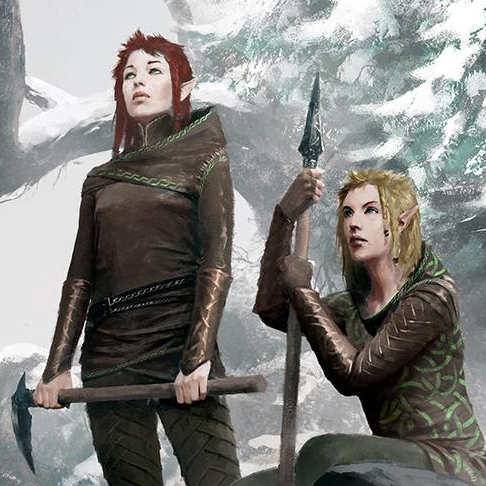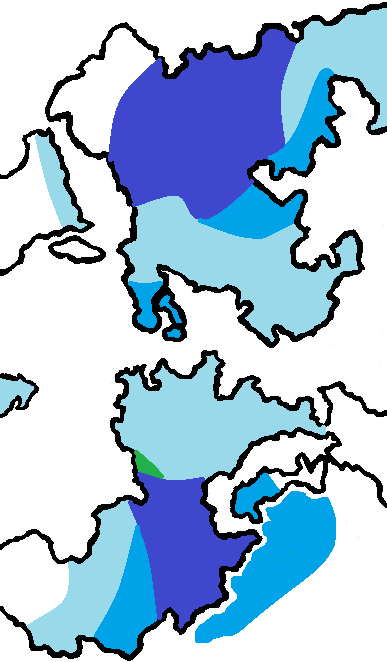Elf
Summary
Elves are among the most powerful and influential ancestries on Vrashyn. Elves are known for changing parts of life others consider immutable, including marriages, occupations, and genders. That said, Elves are also prone to xenophobia and delusions of superiority. Cuilaew cuil - Live many lives.Subraces
The ascendant force on Vrashyn since their defeat of the old Dwarvish Kingdoms, the predominantly High Elf population of Laivra have built the greatest cities on the plane and enjoy an unparalleled standard of living. Not to be outdone, their mostly Wood Elf cousins on Rhovra are some of the most accomplished artists and scholars on the plane, drawing inspiration from their natural surroundings. The less numerous subraces are covered in more detail in articles about their homelands. The rival Eladrin and Shadar Kai come from the Feywild and Shadowfell respectively. Drow live in the Underdark and in the fungal forests of the Mycelian Collective. The Sea Elves live in the Sea of Glinneas and around the island of Meotyi.Appearance
The main distinguishing feature of the elves is their pointed ears, which can range from the slightly-pointed tips of Half-Elves to the inches-long lobes of Wood Elves. Both are typically 5 to 6 feet in height and 100-200 pounds in weight, and like to wear their hair long. Within these two groups, skin and hair color Vary with Location. Fashion preferences are split by landscape rather than by continent: High Elves prefer layers of decorative leather, cotton, and silk, while Wood Elves prefer practical leather clothes. Elves have no body hair even in old age, and their predominant eye colors are blue, green, and amber.Culture
Elves derive their values from the woodlands their ancestors emerged from, preferring to maintain harmony but capable of extreme emotional intensity and violence when provoked. Elves tend to be good-aligned and, with Wood Elves more likely to be chaotic and High elves more neutral in disposition. Though the elves of Laivra are usually monotheists and tacitly worship their traditional creator god Corellon, the spiritual aspect of this religion has become less important over the centuries. Traditional festivals like the Tolta Coronar primarily exist to serve political and social functions.Livelihood
Elves possess advanced knowledge in arcane studies, architecture, and battle tactics. Many Elves work for their monarch in some capacity, as Elvish kings and queens are great patrons of the arts and sciences, funding some of the largest universities in Vrashyn. While not great lovers of games, Elves excel in music, painting, and especially dancing. Though meat is an important part of the diet of Wood Elves, many High Elves are vegetarians. Elves are known for their wine, rare herbs, and vegetable-heavy cuisine.Upbringing
Unless they regularly interact with shorter-lived races, Elves are reserved in their romances. They see sexuality as a private (though not at all shameful) part of life. As the Elvish phrase above attests, Elves experience far more than other races in their lifetimes. Though Elves form marital bonds, they usually break these after their children grow up. This sometimes accompanies a change in home, profession, or gender as well.Relations with Others
Most races have mixed feelings about the Elves. While Humans, Halflings, and Gnomes often see their Elvish overlords as elitist prudes, this comes more from a healthy dose of class consciousness than it does from racial animosity. A major exception to this occurs in Parthil, which has a ruling class of intermarried Gnomes and Elves. The Dwarves, on the other hand, have a true hatred for elves due to the role the Elves played in The Great Dwarven Wars (2897-2963 AK). Individuals Elves and Dwarves are often friendly, but their rulers keep their political interactions restricted to trade. The relationship between Elves and Satyrs is mixed. Siligond and the Satyr kingdoms to its north have repeatedly gone to war, while Athrada and Masyros share a close partnership.
Age
Although elves reach physical maturity only a little more slowly than humans, the elven understanding of adulthood goes beyond physical growth to encompass worldly experience. Elves are typically only entrusted with political and parental responsibilities after their first century of life.
Alignment
Elves love freedom, variety, and self-expression, so they lean strongly toward the gentler aspects of chaos. Like their fey ancestors, they don't tend toward good or evil as a group.
Size
Elves range from under 5 to over 6 feet tall and are more slender on average than other humanoids.
Languages
Elves know the local Elvish language and another local language of their choice. Elvish languages are divided loosely between the largest kingdoms. For first languages, Northwest Laivan (Parthilian) Elves speak Gnomish or Carjuine, East Laivrans (Cirithasi) speak almost exclusively Carjuine, and Sothern elves (Athradans) tend to speak Sylvan. In Southern Rhovra, nearly all Elves speak High Elven.
Remove these ads. Join the Worldbuilders Guild












Comments